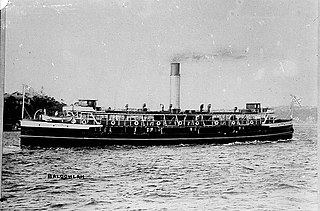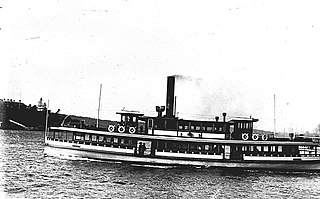
SS Balgowlah was a ferry on Sydney Harbour operated by the Port Jackson & Manly Steamship Company on the Manly service from 1912 until 1951.

HMAS Koompartoo was a Sydney Ferries Limited K-class ferry later converted to an Royal Australian Navy boom defence vessel.
Sydney Ferries Limited operated ferry services on Sydney Harbour from 1900 until June 1951.

The MV North Head was a ferry operated by the Port Jackson & Manly Steamship Company and its successors on the Manly service from 1913 until 1985.

Karrabee was ferry operated by Sydney Ferries Limited and its NSW State Government operated successors on Sydney Harbour from 1913 until 1984. A wooden ferry built at the time of Sydney Ferries' rapid early twentieth century, she and near "sister", Karingal, were the smallest of the fleet of round-end "K-class ferries".

Lady Denman is a former Sydney Harbour ferry built in 1912 for the Balmain New Ferry Company. She was later run by Sydney Ferries Limited and its government successors. She is now preserved at the Jervis Bay Maritime Museum near her original build site in Huskisson, New South Wales, Australia.

The K-class ferries were a group of double-ended screw steam ferries run by Sydney Ferries Limited and its government successors on Sydney Harbour. The company introduced more than two dozen of the vessels from the 1890s through to the early twentieth century to meet the booming demand for ferry services across Sydney Harbour prior to the opening of the Sydney Harbour Bridge in 1932.

Koree was a "K-class" ferry on Sydney Harbour. Launched in 1902, the timber-hulled steamer was built for Sydney Ferries Limited during the boom in cross-harbour ferry travel prior to the opening of the Sydney Harbour Bridge.

The Kirrule-type ferries - Kiandra, Kirrule and Kubu - were three identical K-class ferries that operated on Sydney Harbour by Sydney Ferries Limited.

Kummulla was a "K-class" ferry on Sydney Harbour. Launched in 1903, the timber-hulled steamer was built for Sydney Ferries Limited during the boom in cross-harbour ferry travel prior to the opening of the Sydney Harbour Bridge. She was decommissioned in 1934 after the 1932 opening of the Bridge.

Kameruka and Kamiri were near identical ferries that served on Sydney Harbour. Kamiri was built in 1912 and Kameruka was launched on 8 February 1913. They were double-ended "K-class" steam ferries, a type that was prolific on Sydney Harbour in the early 20th century boom in cross-Sydney Harbour ferry transport before the 1932 opening of the Sydney Harbour Bridge. Kamiri was laid up in 1951 following the New South Wales government take-over of the Sydney Ferries Limited. Kameruka was converted to diesel in 1954 and was laid up in 1984.

Kanimbla was a "K-class" ferry on Sydney Harbour. Launched in 1910, the timber-hulled steamer was built for Sydney Ferries Limited during the boom in cross-harbour ferry travel prior to the opening of the Sydney Harbour Bridge. Kanimbla was renamed "Kurra-Ba" in 1935. She was laid up in the 1940s and broken up in the 1950s.

Lady Scott, later John Cadman and Harbour Queen was a Sydney Harbour ferry built in 1914 for the Balmain New Ferry Company. She and four similar ferries, Lady Chelmsford (1910), Lady Denman (1912), Lady Edeline (1913), and Lady Ferguson (1914), were a new series of "Lady-class", designed by renowned naval architect, Walter Reeks.

Lady Edeline was a Sydney Harbour ferry built in 1913 for the Balmain New Ferry Company. She and four similar ferries, Lady Chelmsford (1910), Lady Denman (1912), Lady Ferguson (1914), Lady Scott (1914) were a new series of "Lady-class", designed by renowned naval architect, Walter Reeks.

Kareela was a "K-class" ferry on Sydney Harbour. Launched in 1905, the double-ended timber-hulled steamer was built for Sydney Ferries Limited in response to the early twentieth century boom in cross-harbour ferry travel prior to the opening of the Sydney Harbour Bridge. She was the first of Sydney Ferries Limited's boats to have a fully enclosed upper deck.

Lady Ferguson was a Sydney Harbour ferry built in 1914 for the Balmain New Ferry Company. She and four similar ferries, Lady Chelmsford (1910), Lady Denman (1912), Lady Edeline (1913), and Lady Scott (1914), were a new series of "Lady-class", designed by renowned naval architect, Walter Reeks.

Kosciusko was a "K-class" ferry on Sydney Harbour. Launched in 1911, the timber-hulled steamer was built for Sydney Ferries Limited during the boom in cross-harbour ferry travel prior to the opening of the Sydney Harbour Bridge.

Sydney Harbour ferry services date back to the first years of Sydney's European settlement. Slow and sporadic boats ran along the Parramatta River from Sydney to Parramatta and served the agricultural settlements in between. By the mid-1830s, speculative ventures established regular services. From the late-nineteenth century the North Shore developed rapidly. A rail connection to Milsons Point took alighting ferry passengers up the North Shore line to Hornsby, New South Wales via North Sydney. Without a bridge connection, increasingly large fleets of steamers serviced the cross harbour routes and in the early twentieth century, Sydney Ferries Limited was the largest ferry operator in the world.

Kaludah was a K-class ferry on Sydney Harbour, Australia. Commissioned in 1909, the timber-hulled steamer was built for Sydney Ferries Limited during the boom in cross-harbour ferry travel prior to the 1932 opening of the Sydney Harbour Bridge. Like the other "K-class" ferries, she was double-deck, double-ended, steam-powered screw ferry. However, she and the larger but otherwise similar Kookooburra (1907), were the only two K-class ferries designed by naval architect Walter Reeks and not Sydney Ferries Limited's Captain Summerbell.

Karingal was a ferry operated by Sydney Ferries Limited and its NSW State Government operated successors on Sydney Harbour from 1913 until 1984. A wooden ferry built at the time of Sydney Ferries' rapid early twentieth century, she was the smallest of the round-end "K-class ferries".

































